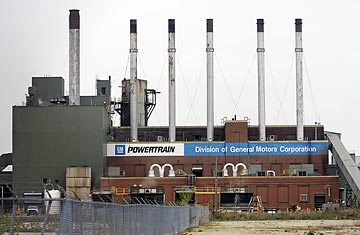
Willow Run in Ypsilanti, Mich.
The announcement by General Motors that it will close its Willow Run transmission plant as part of its restructuring is being taken as a sign of how far the auto giant has fallen. Willow Run is, deservedly, a legend. But the lessons from its history are not entirely the ones usually drawn.
Willow Run, almost on the edge of Ann Arbor, Mich., was built not by GM but by Ford, opening in April 1942. From the start, its job was to turn out B-24 bombers, the workhorse of the U.S. Army Air Force's strategic campaigns in World War II, unaffectionately known to its crews as "the flying shithouse." The plant took a while to get going. There was a shortage of local labor, which meant that workers had to be imported from Appalachia (Ypsilanti, a local town, became known as "Ypsitucky"). Mosquitoes plagued the site until Henry Ford imported a bug-eating fish that Mussolini had found useful in draining the Pontine marshes in Italy. By 1944, Willow Run was turning out a B-24 every hour (it later got the time down to 55 minutes), and all told, it produced 9,000 of them.
Willow Run is always trotted out as Exhibit A in the transformation of lower Michigan into the world's arsenal of democracy. It's a great story, and it's a true one; in 1942, GM took just two months to convert its Cadillac assembly line to one that could turn out tanks. The University of Michigan at Ann Arbor buzzed with boffins working on government contracts, and in 1948, the campus had 21,000 students enrolled — or a fifth of the total number of students at every university in France. Two years earlier, a veteran editor of the Detroit Free Press wrote, without irony, "Detroit has been hailed as Detroit the Dynamic, Detroit the Wonder City."
But Detroit's golden age was very short-lived. Willow Run was never a massive success in peacetime. Henry Kaiser, who wanted to rival the Big Three, bought the plant, and in 1947 he employed 15,000 people there. But by 1953, when the plant was sold to GM, the number had dropped to 3,000. The city was already on its way to being the epitome of the Rust Belt basket case. In 1950, Detroit had a population of nearly 1.85 million; by 1990, it had fallen to just over 1 million.
Did unions, management, civic leaders and just about everyone else in Michigan mismanage the postwar years? Of course. But the real point about Detroit is not that it fell so far, but that it once rose so high. Its economic success during World War II and the immediate aftermath was a freak of geopolitics. With most of the rest of the world (including some regions that were as technologically advanced as Michigan) consumed by war, only the U.S. and Canada were able to develop the high-tech industries of scale that were needed to fight the Axis powers. So successful were those North American industries in developing a mass middle-class standard of living that three generations of Americans were seduced into assuming that the prosperity of Detroit's golden age was normal and how America should be. It was nothing of the sort. It was an accident of world war, and the sooner we recognize its transitory, contingent nature, the shorter will be our mourning for its passing.
This piece is based on a passage from Elliott's 1996 book The Day Before Yesterday.